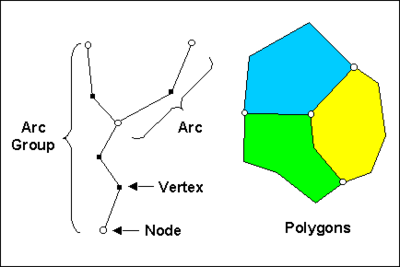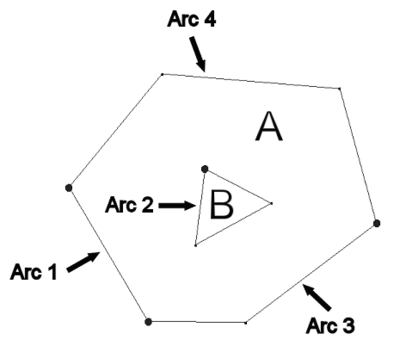WMS:Feature Objects
Feature objects in WMS have been patterned after Geographic Information Systems (GIS) objects and include points, nodes, arcs, and polygons. Feature objects can be grouped together into coverages, each coverage defining a particular set of information. The use of feature objects is determined by the coverage, or attribute set, to which they belong, but can be separated into three important categories:
- As a means of defining basin polygons and stream networks of pre-delineated watersheds (typically this data would be imported as a shapefile from ArcView or ArcInfo where the basin delineation and attribution has already taken place)
- To define a conceptual model or layout of features in the watershed, such as its rough boundaries and streams. This conceptual model is then used to aid in the construction of a TIN or DEM processing for delineating watershed and sub-basin boundaries
- Soil, land use, rainfall, or other data which can be used to define important hydrologic modeling parameters such as curve number (CN) or rainfall zone.
Feature Object Types
The definition of feature objects in WMS follows that used by typical GIS software that supports vector data. The basic object types are points, nodes, vertices, arcs, and polygons. The relationship between these objects is illustrated in the figure below.
Points
Points are XY locations that are not attached to an arc. Points have unique ids and can be assigned attributes such as a source or sink. Points are often used to refine a mesh in an area of interest. Points are also used when importing a set of XY locations for the purpose of creating arcs or polygons.
Arcs
Arcs are sequences of line segments or edges, which are grouped together as a single "polyline" entity. Arcs have unique ids and can be assigned attributes such as specified head. Arcs are grouped together to form polygons or are used independently to represent geometrical features such as ridges or channels. The two end points of an arc are called "nodes" and the intermediate points are called "vertices".
The vertices in an arc define the shape. As more vertices are added, the shape can be more complex. An arc is split into to arcs by selecting a vertex in the arc and converting that vertex to a node. Two adjacent arcs are merged into a single arc by selecting the node that joins them, and converting it to a vertex. Several tools or utilities are provided for working with arcs. These can be accessed while the select arc tool is active by right-clicking in the graphics window. Some of the tools also require that at least one arc be selected. The tools include:
- Delete the selected (or all) arcs.
- Redistribute vertices
- Reverse arc direction
- Transform
- The standard selection utilities (clear, invert, zoom to selection)
- Select connected arcs
Nodes
Nodes define the beginning and ending XY locations of an arc. Nodes have unique ids and can be assigned attributes.
Vertices
Vertices are XY locations along arcs in between the beginning and ending nodes. They are used solely to define the geometry of the arcs. Vertices do not have ids or attributes.
Polygons
Polygons are a group of connected arcs that form a closed loop. A polygon consists of one or more arcs. If two polygons are adjacent, the arc(s) forming the boundary between the polygons is shared (not duplicated). Polygons may not overlap. However, a polygon can have a hole(s) defined by having a set of closed arcs defining interior polygon(s). An example of a hole is shown in the figure below. In this case, four arcs define two polygons. Polygon A is made up of arcs 1, 2, 3 and 4, whereas polygon B is defined by a single arc (arc 2). For polygon A, arcs 1, 3, and 4 define the exterior boundary whereas arc 2 defines a hole.
Polygons have unique ids and can be assigned attributes. Polygons are used to represent material zones such as main channel, overbank floodplain, lakes, etc.
Related Topics
- Images
- Shapefiles
- Coverages
- Map Module
- Feature Object Guidelines
- Build Polygons
- Creating TINs
- Creating Watershed Models
- GIS Module
WMS – Watershed Modeling System | ||
|---|---|---|
| Modules: | Terrain Data • Drainage • Map • Hydrologic Modeling • River • GIS • 2D Grid • 2D Scatter |  |
| Models: | CE-QUAL-W2 • GSSHA • HEC-1 • HEC-HMS • HEC-RAS • HSPF • MODRAT • NSS • OC Hydrograph • OC Rational • Rational • River Tools • Storm Drain • SMPDBK • SWMM • TR-20 • TR-55 | |
| Toolbars: | Modules • Macros • Units • Digitize • Static Tools • Dynamic Tools • Drawing • Get Data Tools | |
| Aquaveo | ||

